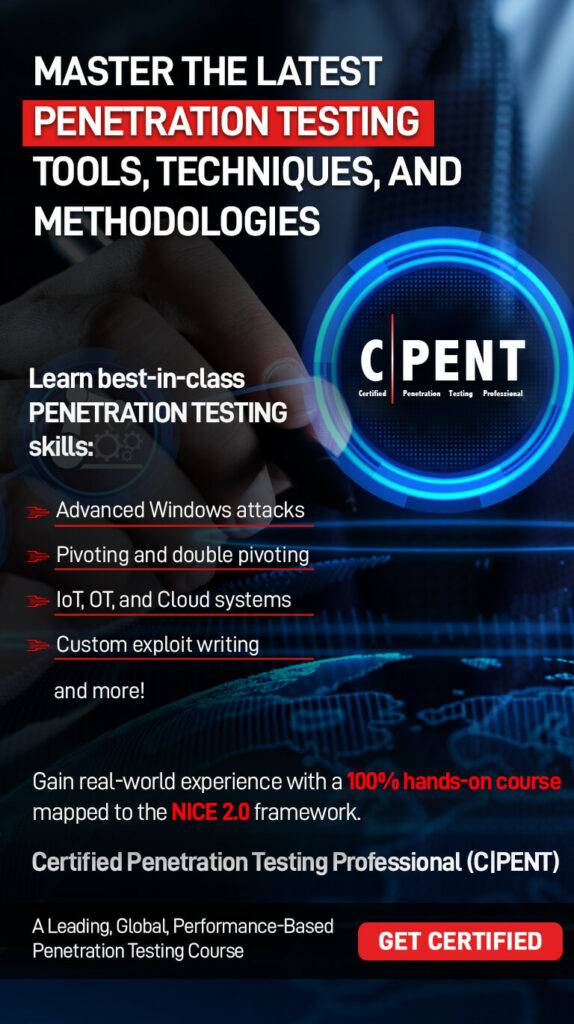The global cyber security industry is growing at a rate of 13.4% a year as companies invest millions to keep cybercriminals at bay. Numerous methods are being employed to accomplish that. Enterprise penetration testing continues to prove to be a fast and reliable tactic for discovering vulnerabilities in a company’s system while revealing actionable changes they can make to improve their security infrastructure.
As the cybersecurity industry grows, the future only gets brighter for penetration testers. As of last year, pentesters earn an average of $88,089 annually in the United States (Payscale, 2022), yet no formal degree or license is required to obtain such a position. Instead, pentesters need hands-on experience and a way to prove their knowledge, which is why EC-Council created the Certified Penetration Testing Professional (C|PENT) exam.
What Is the CPENTAI Exam?
- Pentest IoT and OT systems
- Bypass filtered networks
- Write your own exploits
- Perform advanced Windows attacks
- Conduct advanced privilege escalation
- Conduct binary exploitation
- Single and double pivoting
#1 Inability to Ping Networks Effectively
The CPENTAI exam is meant to test your penetration testing skills in the real world. In enterprise architecture, ICMP is typically not allowed. Even the Windows Defender firewall blocks ICMP by default. Many professionals with other industry certifications miss this fundamental point.
Solution: Use another protocol to discover live targets.
#2 Unable to Gain Machine or Network Access
The CPENTAI exam mimics real-world testing, so you will not have access to all machines, nor will all machines have points you can leverage to gain access. In other words, if you expect to be guided to your targets, you will not have an easy time completing the CPENTAI exam.
Many pentesters that fail the CPENTAI exam run into issues because they do not use custom, tuned scans to discover their targets. They also fail to look at the network traffic at the packet level to see what the network is showing them. As such, they struggle to move forward and successfully complete the pentest.
Solution: Dig deeper to see what you can find on the network.
#3 Failure to Prioritize Targets
Many professionals with other industry certifications fail to plan their strategy. Even if they have one, they fail to practice it using the EC-Council Labs or the EC-Council Practice Range. This means that, once the exam begins, they start hacking away, hoping that something works—but that’s not how it’s done in the real world.
The CPENTAI is like no other in that it prepares you to be part of a professional team, which means managing the scope of a pentest and prioritizing your testing. So, you must practice using different methods to egress data from protected and filtered networks. You should also practice recording information and efficiently extracting data for your report.
Solution: Create an extensive target database before you begin exploiting.
#4 Failure to Implement Systematic Processes
#5 Scans Take Far Too Long to Complete
#6 You Can't Find Any OT Machines
You’d be surprised to learn that among those who failed the CPENTAI exam, including experienced pentesters, many cannot get anywhere close to the OT machines. In the real world, the OT network is rarely directly accessible, and you will have to identify weaknesses on a machine that has access to it to get in.
Like in the real world, the CPENTAI exam requires you to find the communication between the Programmable Logic Controller (PLC) and the slaves. Plus, just like any other communications on the network, it is in TCP/IP packets.
Solution: Know where to find the TCP/IP packets and how to analyze them.
#7 Failure to Attack an Active Directory
Ask yourself: “What would I see in an active directory environment?” Many professionals with other industry certifications could not take what the network gave them. Nor could they look for Kerberos weaknesses and see if they could compromise a ticket.
Solution: Get comfortable finding and understanding your targets.
#8 Inability to Extract Firmware from the IoT Zone
Many professionals with other industry certifications could not check the syntax and verify that they entered the options correctly. As a result, they failed to have privileges to write to the folder where they were extracting the firmware file system to.
Solution: Come up with a strategy before taking action.
#9 Making Incorrect Assumptions
As with any real-world engagement, the CPENTAI exam requires you to analyze what is on the network and, from that analysis, try to find a weakness so you can gain access.
Many professionals with other industry certifications could not take what the network showed them, analyze it, and find a way to gain access. Instead, they made bad assumptions. Just remember this: In a real-world assignment, you will not gain access to every machine every time.
Solution: Be mindful of your assumptions and don’t get led astray.
Prepare For Your Exam with Over 110+ Labs
About the Author
Sydney Chamberlain is a content writer specializing in informational, research-driven projects.
References
Fortune Business Insights. (2022, June 14). With 13.4% CAGR, global cyber security market size to surpass USD 376.32 billion in 2029. GlobalNewswire. https://www.globenewswire.com/news-release/2022/06/14/2461786/0/en/With-13-4-CAGR-
Global-Cyber-Security-Market-Size-to-Surpass-USD-376-32-Billion-in-2029.html
PayScale. (2022, July 27). Average PenTester Salary. https://www.payscale.com/research/US/Job=Penetration_Tester/Salary?loggedIn









